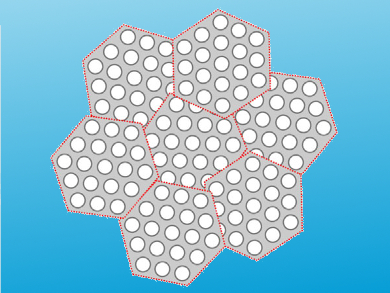Magnetic nanomaterials play a key role in research and industry. Their usefulness is most often determined by the magnetic anisotropy. Therefore, the creation and control of magnetic anisotropy is a research target.
Anne Bleuzen, Institut de Chimie Moléculaire et des Matériaux d’Orsay, CNRS, Université Paris-Sud, Université Paris-Saclay, Orsay, France, and colleagues have used a template approach for the anisotropic assembly of coordination nanocrystals into chains. The team used an ordered mesoporous silica monolith as template. Its mesopores have a 2D-hexagonal structure (pictured). The team grew nanowires from NiFe Prussian blue analog nanoparticles (Ni4[Fe(CN)6]2,7·x H2O) within the nanochannels of the silica. The resulting nanowires are made of single chains of nanocrystals.
Macroscopic fragments of the modified monolith show a remarkably strong anisotropy in their magnetic properties. This effect is caused by a magnetic dipolar interaction along the chains of coordination nanocrystals and is spread to the macroscopic scale thanks to the long-range organization of the pores.
- Macroscopic Magnetic Anisotropy Induced by the Combined Control of Size, Shape and Organization of NiFe Prussian Blue Analog Nanoparticles in an Ordered Mesoporous Silica Monolith,
Robinson Moulin, Giulia Fornasieri, Marianne Impéror-Clerc, Eric Rivière, Patricia Beaunier, Anne Bleuzen,
ChemNanoMat 2017.
DOI: 10.1002/cnma.201700196



